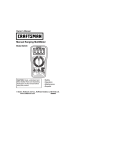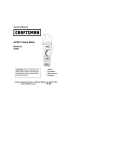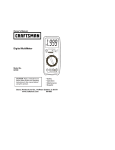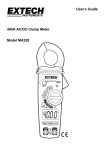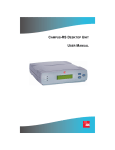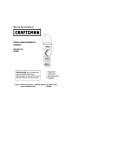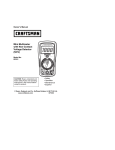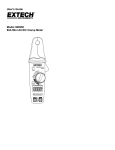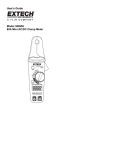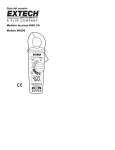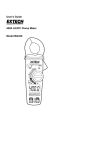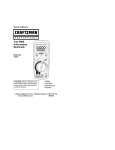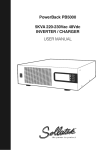Download AC Clamp Meter
Transcript
Owner's Manual AC Clamp Meter Model No. 82372 CAUTION: Read, understand and follow Safety Rules and Operating Instructions in this manual before using this product. • Safety • Operation • Maintenance • Español © Sears, Roebuck and Co., Hoffman Estates, IL 60179 U.S.A www.craftsman.com 061906 TABLE OF CONTENTS Warranty Page 3 Safety Instructions 4 Safety Symbols 5 Control and Jacks 6 Symbols and Annunciators 6 Specifications 7 Operating Instructions 10 AC Current Measurements 10 AC Voltage Measurements 11 DC Voltage Measurements 11 Resistance Measurements 12 Continuity Measurements 12 Diode Testing 13 Auto Power Off 14 Data Hold 14 Max Hold 14 Auto/Manual Ranging 14 Maintenance 15 Battery Replacement 15 Troubleshooting 16 Service and Parts 16 2 ONE YEAR FULL WARRANTY ONE YEAR FULL WARRANTY ON CRAFTSMAN AC CLAMP METER If this CRAFTSMAN Clamp Meter fails to give complete satisfaction within one year from the date of purchase, RETURN IT TO THE NEAREST SEARS STORE OR OTHER CRAFTSMAN OUTLET IN THE UNITED STATES, and Sears will replace it, free of charge. This warranty gives you specific legal rights, and you may also have other rights which vary from state to state. Sears, Roebuck and Co., Dept. 817WA, Hoffman Estates, IL 60179 For Customer Assistance Call 9am - 5pm (ET) Monday through Friday 1-888-326-1006 WARNING: USE EXTREME CAUTION IN THE USE OF THIS DEVICE. Improper use of this device can result in injury or death. Follow all safeguards suggested in this manual in addition to the normal safety precautions used in working with electrical circuits. DO NOT service this device if you are not qualified to do so. 3 SAFETY INSTRUCTIONS This meter has been designed for safe use, but must be operated with caution. The rules listed below must be carefully followed for safe operation. 1. NEVER apply voltage or current to the meter that exceeds the specified maximum: Input Limits Function Maximum Input V DC, V AC 600V DC/AC A AC 400A AC Resistance 250V DC/AC Diode test 250V DC/AC 2. USE EXTREME CAUTION when working with high voltages 3. DO NOT measure voltage if the voltage on the "COM" input jack exceeds 240V above earth ground 4. DO NOT measure current of circuits whose voltage is greater than 240V above earth ground 5. NEVER connect the meter leads across a voltage source while the function switch is in the resistance or diode mode. Doing so can damage the meter ALWAYS turn off the power and disconnect the test leads before opening the doors to replace the fuse or batteries 6. 7. NEVER operate the meter unless the back cover is in place and fastened securely 4 SAFETY SYMBOLS This symbol adjacent to another symbol, terminal or operating device indicates that the operator must refer to an explanation in the Operating Instructions to avoid personal injury or damage to the meter WARNING This WARNING symbol indicates a potentially hazardous situation, which if not avoided, could result in death or serious injury CAUTION This CAUTION symbol indicates a potentially hazardous situation, which if not avoided, may result in damage to the meter MAX 600V This symbol advises the user that the terminal(s) so marked must not be connected to a circuit point at which the voltage, with respect to earth ground, exceeds (in this case) 600 VAC or VDC This symbol adjacent to one or more terminals identifies them as being associated with ranges that may, in normal use, be subjected to particularly hazardous voltages. For maximum safety, the meter and its test leads should not be handled when these terminals are energized This symbol indicates that a device is protected throughout by double insulation or reinforced insulation 5 CONTROLS AND JACKS 1. Current clamp 1 2. MAX Hold button 3. Data Hold button 4. LCD display 6 5. COM input jack 2 6. Clamp Opening Trigger 7. Rotary Function Switch 7 8. V/ jack 3 9. Mode select button 10. Backlight button 4 9 11 11. Range Select button 5 SYMBOLS AND ANNUNCIATORS AC AC (alternating current) DC DC (direct currrent) Minus sign AUTO AutoRange mode •))) Audible Continuity HOLD Data Hold mode Low Battery icon m V A Diode test mode milli Volts Amps M 6 Mega Ohms 10 8 SPECIFICATIONS Function Range AC Current 2.000 AAC 20.00AAC 200.0 AAC 400.0 AAC DC Voltage 200.0mV 2.000V 20.00V 200.0V 600V AC Voltage 200.0mV 2.000V 20.00V 200.0V 600V Resistance 200.0 2.000k 20.00k 200.0k 2.000k 20.00M Accuracy ± (2.5% reading + 10 digits) ± (2.5% reading + 4 digits) ± (2.5% reading + 4 digits) ± (3.0% reading + 5 digits) ± (0.5% reading + 5 digits) ± (1.2% reading + 3 digits) ± (1.5% reading + 3 digits) ± (1.5% reading + 30 digits) ± (1.5% reading + 3 digits) ± (2.0% reading + 4 digits) ± (1.0% reading + 4 digits) ± (1.5% reading + 2 digits) ± (2.0% reading + 3 digits) ± (3.0% reading + 5 digits) NOTE: Accuracy specifications consist of two elements: • (% reading) This is the accuracy of the measurement circuit. • (+ digits) This is the accuracy of the analog to digital converter o o o o NOTE: Accuracy is stated at 65 F to 83 F (18 C to 28 C) and less than 70% RH 7 Clamp size Diode Test Continuity Check Opening 0.9" (23mm) approx. Open circuit voltage <1.5V DC; Test current 0.3mA (typical) Audible signal <120; Input Impedance Test current < 1mA 7.8M (VDC and VAC) Display AC V bandwidth AC A bandwidth AC response Operating Temperature Storage Temperature Operating Humidity Storage Humidity Operating Altitude Over voltage Battery Auto OFF Dimensions/Weight Safety 3-1/2 digits (2000 counts) LCD 50Hz to 400Hz 50/60Hz Averaging o o 41 to 104 F (5 to 40 C) o o -4 to 140 F (-20 to 60 C) Max 80% up to 87ºF (31ºC) decreasing linearly to 50% at 104ºF (40ºC) <80% 6560 ft. (2000 meters) maximum Category III 600V (2) 1.5V AAA Batteries After 30 minutes of continuous use 7.87x1.97x1.38" (200x50x35mm) 0.44 lbs. (200g) This meter is intended for indoor use and protected, against the users, by double insulation per EN61010-1 and IEC61010-1 2nd Edition (2001) to CAT III 600V; Pollution Degree 2. The meter also meets UL 61010-1, Second Edition (2004), CAN/CSA C22.2 No. 61010-1, Second Edition (2004), and UL 61010B2-031, First Edition (2003) 8 UL LISTED The UL mark does not indicate that this product has been evaluated for the accuracy of its readings PER IEC1010 OVERVOLTAGE INSTALLATION CATEGORY OVERVOLTAGE CATEGORY I Equipment of OVERVOLTAGE CATEGORY I is equipment for connection to circuits in which measures are taken to limit the transient overvoltages to an appropriate low level. Note – Examples include protected electronic circuits. OVERVOLTAGE CATEGORY II Equipment of OVERVOLTAGE CATEGORY II is energyconsuming equipment to be supplied from the fixed installation. Note – Examples include household, office, and laboratory appliances. OVERVOLTAGE CATEGORY III Equipment of OVERVOLTAGE CATEGORY III is equipment in fixed installations. Note – Examples include switches in the fixed installation and some equipment for industrial use with permanent connection to the fixed installation. OVERVOLTAGE CATEGORY IV Equipment of OVERVOLTAGE CATEGORY IV is for use at the origin of the installation. Note – Examples include electricity meters and primary overcurrent protection equipment 9 OPERATING INSTRUCTIONS Notice: Read and understand all WARNING and CAUTION statements listed in the safety section of this operation manual prior to using this meter. Set the function select switch to the OFF position when the meter is not in use. NOTES: 1. ALWAYS turn the rotary function switch to the OFF position when the meter is not in use 2. If “OL” appears in the display during a measurement, the value exceeds the range you have selected. Change to a higher range AC CURRENT MEASUREMENTS WARNING: Disconnect the test leads from the meter before making current clamp measurements. 1. Set the Function switch to the 400AAC, 200AAC, 20AAC or 2AAC range. If the range of the measured current is not known, select the higher range first then move to the lower range if necessary. Yes 2. Press the trigger to open jaw. Fully enclose one conductor to be measured. Note: Do not put more than one wire inside the current clamp. 3. The clamp meter LCD will display the reading. No 10 DC/AC VOLTAGE MEASUREMENTS WARNING: Risk of Electrocution. The probe tips may not be long enough to contact the live parts inside some 240VAC outlets for appliances because the contacts are recessed deep in the outlets. As a result, the reading may show 0 volts when the outlet actually has voltage on it. Make sure the probe tips are touching the metal contacts inside the outlet before assuming that no voltage is present. CAUTION: Do not measure DC or AC voltages if a motor on the circuit is being switched ON or OFF. Large voltage surges may occur that can damage the meter. 1. Set the rotary function switch to the VAC position for AC Voltage or VDC position for DC Voltage. 2. Insert the black test lead banana plug into the negative (COM) jack and the red test lead banana plug into the positive (V/) jack 3. Connect the test leads to the circuit under test 4. Read the voltage on the display. The display will indicate the proper decimal point and value. For DC voltage, if the polarity is reversed, the display will show (-) minus before the value 11 V RESISTANCE MEASUREMENTS WARNING: To avoid electric shock, disconnect all power to the unit under test, remove the batteries, unplug the line cords and discharge all capacitors before taking any resistance measurements. 1. 2. 3. 4. Set the function switch to the •))) position. Insert the black test lead banana plug into the negative (COM) jack and the red test lead banana plug into the positive (V/) jack Touch the test probe tips across the circuit or part under test. It is best to disconnect one side of the part under test so the rest of the circuit will not interfere with the resistance reading Read the resistance in the display Ohms CONTINUITY CHECK WARNING: To avoid electric shock, never measure continuity on circuits or wires that have voltage on them. 1. 2. 3. 4. 5. Set the function switch to the •))) position. Push the mode button to indicate •))) on the display. Insert the black lead banana plug into the negative (COM) jack Insert the red test lead banana plug into the positive (V) jack. Touch the test probe tips to the circuit or wire you wish to check. If the resistance is less than approximately 120, the audible signal will sound. If the circuit is open, the display will indicate “OL.”. 12 DIODE TEST WARNING: To avoid electric shock, do not test any diode that has voltage on it. 1. Turn the rotary switch to the •))) position. 2. Insert the black test lead banana plug into the negative (COM) jack and the red test lead banana plug into the positive (V) jack. 3. Push the mode button to indicate on the display. 4. Touch the test probes to the diode under test. Typically for a normal diode, forward voltage will indicate 0.4V to 0.7V. Reverse voltage will indicate “OL”. Shorted devices will indicate near 0V and an open device will indicate “OL” in both polarities. 13 AUTO POWER OFF To extend the battery life, the meter will enter the sleep mode after 30 minutes of continuous use. Turn the function switch to the OFF position to shut the meter OFF and then to the needed function to resume operation. DATA HOLD To freeze the LCD meter reading, press the HOLD button. While data hold is active, the HOLD display icon appears on the LCD. Press the HOLD button again to return to normal operation. MAX Hold To hold the highest reading on the LCD, press the MAX button. The max hold button is located on the left side of the meter (top button). While data hold is active, the MAX display icon appears on the LCD. The meter reading will not change as readings change, rather it will only display the highest reading encountered since the max hold button was pressed. Press the max hold button again to return to normal operation. AUTO/MANUAL RANGING The meter turns on in Autoranging mode. Press the RANGE button to enter manual ranging. Each press of the range button will step to the next range as indicated by the units and decimal point location. Press and hold the RANGE button for two seconds to return to Autoranging mode. Note: Manual ranging does not function in AC Current or Diode and Continuity check functions. 14 MAINTENANCE WARNING: To avoid electric shock, do not operate your meter until all covers are in place and fastened securely. This meter is designed to provide years of dependable service, if the following care instructions are performed: 1. KEEP THE METER DRY. If it gets wet, wipe it off. 2. USE AND STORE THE METER IN NORMAL TEMPERATURES. Temperature extremes can shorten the life of the electronic parts and distort or melt plastic parts. 3. HANDLE THE METER GENTLY AND CAREFULLY. Dropping it can damage the electronic parts or the case. 4. KEEP THE METER CLEAN. Wipe the case occasionally with a damp cloth. DO NOT use chemicals, cleaning solvents, or detergents. REPLACING THE BATTERIES WARNING: To avoid electric shock, disconnect the test leads from any source of voltage before removing the battery door. 1. When the batteries become exhausted or drop below the operating voltage, the low battery indicator will appear in the LCD display. The batteries should then be replaced. 2. Disconnect the test leads from the meter. 3. Open the battery door by removing the rear screws using a Phillips head screwdriver. 4. Insert the batteries into battery holder. 5. Put the battery door back in place. Secure with the screws. 6. Dispose of the old batteries properly. WARNING: To avoid electric shock, do not operate the meter until the battery door is in place and fastened securely. NOTE: If your meter does not work properly, check the battery ensuring that it is still good and properly inserted. 15 TROUBLESHOOTING There may be times when your meter does not operate properly. When this occurs, check the following: Meter Does Not Operate 1. Review all the instructions in this manual. 2. Check to be sure the battery is properly installed. 3. Check to be sure the battery is good. 4. If the battery is good and the meter still does not operate, check to be sure that both ends of the fuse are properly installed. If You Need Assistance Understanding How the Meter Works 1. 2. Purchase the instructional book Multitesters and Their Use for Electrical Testing (Item No. 82303) at your local Sears store. Call our Customer Service Line 1-888-326-1006. SERVICE AND PARTS Item Number 82398 82372-DB 82372-CS Description Set of black and red Test Leads Replacement battery door Rear cover screws For replacement parts shipped directly to your home Call Monday through Friday, 9 AM – 5 PM Eastern Time 1-888-326-1006 16
















